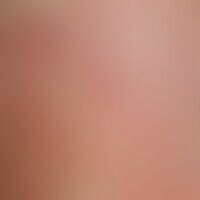
Necrobiosis lipoidica L92.1
Necrobiosis lipoidica: a condition that has existed for years and is constantly worsening; no diabetes mellitus known.

Lichen planus classic type L43.-
Lichen planus. chronically active, multiple, increasing, disseminated standing, partly confluent, first appearing about 6 months ago, mainly localized at the inner edge and back of the foot, 0.3-0.6 cm large, itchy, red, smooth, shiny papules in a 46-year-old woman. similar papules appeared on both inner wrist sides. Furthermore, a whitish, net-like pattern of the buccal mucosa of the mouth appeared.

Vascular malformations Q28.88
Malformations, syndromal vascular: Nevus flammeus (capillary malformation, no arterio-venous anastomoses) with soft tissue atrophy and pelvic obliquity, no pain symptoms.

Vasculitis leukocytoclastic (non-iga-associated) D69.0; M31.0
Vasculitis, leukocytoclastic (non-IgA-associated). exanthematic seeding of dense macular to maculopapular reddish-brownish efflorescences.

Bowen's disease D04.9
Bowen's disease with transition to Bowen's carcinoma: solitary, size-progressive plaque that has been present for several years, occasionally accompanied by itching, sharply and arc-shaped, border-emphasized plaque with increasing verrucous nodular formation (see following figure).

Vasculitis leukocytoclastic (non-iga-associated) D69.0; M31.0
Vasculitis, leukocytoclastic (non-IgA-associated). multiple, acute, symmetric, localized on both lower legs for 1 week, irregularly distributed, 0.1-0.2 cm large, sharply defined, symptomless, red, smooth patches (non-compressible). Occurrence after flu-like infection and ingestion of a non-steroidal anti-inflammatory.

Early syphilis A51.-
Syphilis acquisita: papular, completely asymptomatic (recurrent) exanthema (no itching) Important: generalized lymphadenopathy.

Antiphospholipid syndrome D68.8

Cholesterol embolisation syndrome T88.8
Cholesterol embolism: extensive, progressive, flat ulcerations with necrotic deposits, highly painful margins and livid erythema in a patient with AVK.

Livedovasculopathy L95.0
Livedovasculopathy: haemorrhagic-necroticlesions on erythematous ground. periulcerous livedo image. healing leaving star-shaped, whitish scars.

Linear IgA dermatosis L13.8

Vasculitis leukocytoclastic (non-iga-associated) D69.0; M31.0
Vasculitis, leukocytoclastic (non-IgA-associated). multiple, since 1 week existing, on both lower legs localized, irregularly distributed, 0.1-0.2 cm large, confluent in places, symptomless, red, smooth spots (not compressible).

Dermatofibroma hemosiderin storing D23.L

Intermediate leprosy A30.8
Dimorphic leprosy of the lepromatous type: borderline leprosy of the lepromatous type with multiple, large, plate-like, borderline inflammatory lesions (type I leprosy reaction).

Hypertrophic Lichen planus L43.81
Lichen planus verrucosus: Plaques on the left lower leg that have been unchanged for years and are very itchy (see scratching effects), with a red-violet seam in the marginal parts of the plaques.









